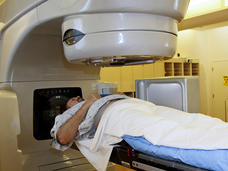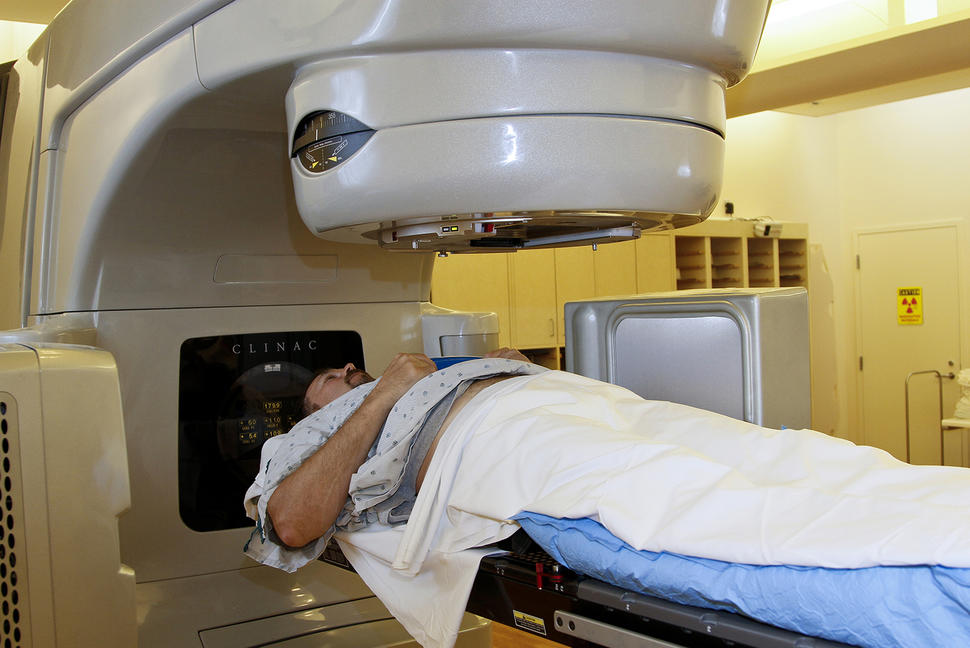, by NCI Staff
Many people with prostate cancer can safely receive a shorter, more intensive course of radiation therapy after surgery than has conventionally been used, a new study has found.
In a large clinical trial, people who received the shorter course of treatment, which lasted for 5 weeks, reported more bowel problems immediately following treatment than those who underwent the standard 7 weeks of less-intensive radiation. However, by 6 months after treatment, both groups reported similar levels of bowel problems and an overall equivalent quality of life.
The study relied on patients reporting the side effects related to treatment and their overall well-being, known as patient-reported outcomes.
“Physician-reported toxicities can sometimes lead us astray,” said Mark Buyyounouski, M.D., a radiation oncologist at Stanford University who led the trial. “Not everything that can be counted [by us] counts to patients. So we wanted to know: When do [people] tell us that they’re feeling good again?”
The results of the study, which was run by the NCI-funded clinical cooperative group NRG Oncology, were presented on October 25 at the 2021 American Society for Radiation Oncology Annual Meeting.
Even though the use of higher radiation doses over a shorter period, called hypofractionated postoperative prostate bed radiotherapy, or HYPORT, did have more side effects in the near term, many people are likely to consider that a worthwhile tradeoff for 2 fewer weeks of treatment, said Deborah Citrin, M.D., of NCI’s Center for Cancer Research, who was not involved in the study.
“For a lot of patients, coming in every [weekday] for 7 weeks has a major impact on their lives,” she said. “There’s a lot of interest in hypofractionation because getting treatment done more quickly is so much easier, financially and otherwise.”
A Large Role for Radiation Therapy
People diagnosed with localized prostate cancer—that is, disease that hasn’t spread outside the prostate region—have many potential treatment options, depending on the stage and grade (potential aggressiveness of the tumor). Some may have surgery alone. Others may only have radiation therapy.
And some may have a combination of the two. This often happens when there’s concern that surgery hadn’t removed all the tumor tissue. Or, if someone’s prostate-specific antigen (PSA) levels start to rise months or years after surgery, radiation therapy may be recommended even if imaging hasn’t been able to identify tumor growth.
Hypofractionated radiation therapy is already an accepted treatment option for some people undergoing radiation therapy alone to treat prostate cancer. But whether this type of radiation therapy is appropriate for use after surgery has been unclear.
When radiation is used after surgery, it’s delivered to a larger area of the body, including sensitive areas in the bladder and rectum, Dr. Buyyounouski explained. This raises the possibility that the higher doses used in hypofractionation may cause long-term side effects that could outweigh the benefit of two fewer weeks of treatment for these patients.
“And a lot of people do have some urinary complications after surgery,” said Dr. Citrin. “So even a small increase in urinary or bowel symptoms that persist after treatment with one [treatment] regimen versus the other could be quite impactful in terms of quality of life.”
To test whether hypofractionation affected these patients’ quality of life differently than conventional fractionation, the NGR Oncology researchers enrolled almost 300 participants from more than 90 treatment centers across the country into the trial.
An Inclusive Clinical Trial
The team designed the phase 3 trial to be as inclusive as possible to capture a population that looks like people commonly treated in the community, Dr. Buyyounouski explained. The participants included both people getting radiation immediately after surgery and those who waited until they had rising PSA levels.
Participants who had some invasion of their cancer into nearby tissue were eligible, although those whose cancer had spread to their lymph nodes were excluded. They could also receive up to 6 months of androgen deprivation therapy, a type of hormone therapy, if recommended by their doctor.
Participants were randomly assigned to treatment with HYPORT, consisting of a higher dose (or fraction) of radiation every weekday for 5 weeks or the commonly used, lower dose every weekday for 7 weeks. They were asked about urinary and bowel symptoms before radiation and 6, 12, and 24 months after treatment, using the Expanded Prostate Cancer Index Composite (EPIC) questionnaire.
After prostate cancer treatments, common urinary symptoms can include urine leakage or pain or burning when urinating. Common bowel symptoms can include bowel leakage or urgency. The trial did not measure sexual side effects, such as erectile dysfunction, since these can also be affected by hormone therapy.
About three-quarters of the participants completed all questionnaires. At the end of treatment, people who received HYPORT reported more bowel side effects, although urinary side effects were equivalent between groups.
By 6 months after treatment, this difference in bowel symptoms had disappeared, and people in both groups reported equivalent quality of life for both bowel and urinary symptoms. The groups continued to report similar and relatively low levels of symptoms for up to 2 years after finishing treatment.
No differences in cancer recurrence were seen between the two groups. The NRG Oncology team will continue to track recurrences over time but do not expect to see any difference emerge, Dr. Buyyounouski said. The two groups received the same overall radiation dose, and other trials of hypofractionation compared with conventionally fractionated radiation therapy in people with similar forms of prostate cancer who did not have surgery have not shown differences in recurrence or survival.
“That’s why, in a situation where the disease control outcomes are likely to be similar, what really matters to a patient is: How am I going to feel?” Dr. Citrin said.
Helping People Imagine Their Future
“The hardest thing we can do as physicians is help patients envision their future selves,” Dr. Buyyounouski said. “So patient-reported outcomes are very helpful, because you can tell [other] patients exactly what side effects people had, and the frequency and bother of those side effects at [different] points in time.”
For many, he added, the trade-off in more side effects right after treatment will be worth it for a shorter treatment duration.
“Unless you’ve been a patient, it’s hard for folks to imagine all the things that need to happen for somebody to go and get treatment every [weekday]” for weeks, Dr. Buyyounouski said.
“There’s transportation costs, gas, parking, co-pays. And there are costs associated with the things you’re not doing, like time away from work or responsibilities at home. It’s more than just the medical bills.”
“I think people are itching to shorten the treatment [duration] because there are a lot of patients for whom it’s a barrier to getting treatment. And radiation therapy is a potentially curative treatment,” added Dr. Citrin. “So, making it easier for patients without increasing the long-term side effects … is a huge win.”
However, a less-intensive standard course of radiation will still likely appeal to some people, she added, especially if they are experiencing ongoing side effects from surgery.
The results of the current study also aren’t immediately applicable to everyone having radiation therapy after prostate cancer surgery. For example, the study didn’t include people who needed radiation to their lymph nodes. The results can’t explicitly provide guidance on the impact of hypofractionation on quality of life for these patients, Dr. Citrin explained.
But for people who have tumors similar to those treated in the current trial, the machines and expertise used for this type of radiation can be commonly found across the country, Dr. Buyyounouski explained.
“So we want people to know that this is available near you,” he said. The only caveat for someone looking to receive HYPORT is that the trial used image guidance for all patients. This procedure uses technologies like CT or ultrasound to help clinicians guide where the radiation therapy is delivered. “That’s something to make sure [your local provider] is using,” he added.
Several ongoing clinical trials are looking at whether prostate radiation therapy can be compressed any further for select patients, Dr. Citrin added. For example, her group is currently running a clinical trial testing hypofractionated radiation delivered over the course of 2 to 4 weeks.
Recent advances in prostate imaging may also allow for more personalized radiation therapy, which could potentially help reduce side effects, said Dr. Citrin. For example, the Food and Drug Administration recently approved PSMA-based PET-CT imaging to look for tiny cancer deposits in the prostate or elsewhere in the body. This may allow oncologists to target smaller areas of tissue more effectively, or to avoid radiation treatment in patients who are unlikely to benefit from it.
“Ongoing research in radiation oncology is often aimed at making radiation therapy more convenient, less toxic, and less expensive for patients, while maintaining excellent cure rates,” Dr. Citrin said.







